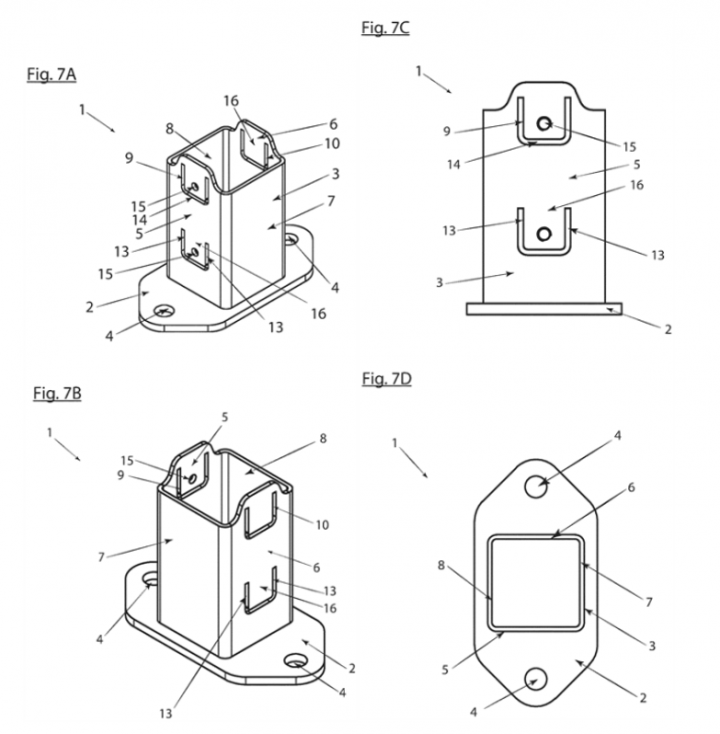Applicant(s): BOPLAN NV
Inventor(s): Xavier RAMON
Patent application number: WO2023232769
Publication date: 2023-12-07
The problem
Upwardly extending posts are well-known and commonly utilized in the construction of fences or as a form of collision protection. Specifically, in the case of collision protection, these posts are positioned on a surface within a building, such as a warehouse, or on a paved area like a parking lot. Due to these circumstances, it is simply not feasible to secure an upwardly extending post in a hole within the surface. This approach is also not advisable as these posts need to be easily replaceable in the event of damage caused by a collision. Consequently, these upwardly extending posts are affixed to a base member that is securely attached to the surface. The connection between the upwardly extending posts and the base members must be strong to prevent the posts from becoming detached in the event of a mechanical impact.
A method for linking an upwardly extending post to a base member is disclosed in US 2012/0321826 (US '826). According to US '826, the upwardly extending post is a hollow component made by extruding plastic material. A rigid support member and the hollow component are forcefully joined together, causing the hollow component to slide over the support member. As the hollow component moves relative to the base member, it undergoes elastic deformation, resulting in a secure connection between the two. However, this existing method has a drawback in that the hollow component cannot be detached from the support member. Consequently, if the upwardly extending post sustains damage, both the support member and the hollow component must be removed and replaced, leading to unnecessary waste of material. Moreover, replacing the upwardly extending post requires additional effort as a new support member must be affixed to the surface and a new hollow component must be connected to the support member, rather than simply replacing the broken hollow component.
The present invention seeks to address the issue.
The solution
The present invention relates to a base member for attaching an upwardly extending post to a surface. The present invention also relates to a method for attaching an upwardly extending post to a surface and to a use of the base member and/or the method for creating a collision protection.
The base member comprises a bottom plate and a hollow connection profile, wherein the connection profile comprises at least a first pair of cuts, wherein a cut forms a pliable lip, wherein the pliable lip extends in a direction transverse to the bottom plate, wherein a first cut is comprised in a first side and a second cut in a second side of the connection profile, opposite said first side, wherein both cuts are at a same distance from the bottom plate, wherein both pliable lips formed by the cuts are oriented in a same direction, wherein said first pair comprises a bolt, and wherein said bolt is placed in a threaded hole in the pliable lip formed by the first cut.
The advantage of such a base member is that an upwardly extending post can be firmly attached to the base member, while remaining detachable. By tightening the bolt, the pliable lips formed by the first cut and the second cut will be clamped against the upwardly extending post. This causes sufficient friction between the base member and the upwardly extending post, so that the base member and the upwardly extending post are firmly secured to each other. This is additionally beneficial because energy of a mechanical impact on the upwardly extending post is transferred via these pliable lips, and not only via the bolt, avoiding high tension on a single point and significantly reducing the risk on failure of the bolt. In case the upwardly extending post gets damaged, the upwardly extending post can be detached from the base member by loosening the bolt. The pliable lips will at least partly return towards an original position at the first side and the second side of the connection profile, and will not be any longer clamped against the upwardly extending post. The upwardly extending post and the connection profile are not any longer secured to each other. The base member can be reused for attaching a replacement upwardly extending post. Only the replacement upwardly extending post needs to be reattached to the base member.
Summary advantages
The main advantage in that in case the upwardly extending post gets damaged, the upwardly extending post can be detached from the base member by loosening the bolt. This is a simple and fast action. The base member can be reused for attaching a replacement upwardly extending post.
Independent Claims
Base member for attaching an upwardly extending post to a surface, comprising a bottom plate and a hollow connection profile for connecting the upwardly extending post to the base member, wherein the connection profile is firmly fixed to the bottom plate, wherein the connection profile extends in a direction transverse to the bottom plate, characterized in that the connection profile comprises at least a first pair of cuts, wherein a cut forms a pliable lip, wherein the pliable lip extends in a direction transverse to the bottom plate, wherein a first cut of said first pair is comprised in a first side of the connection profile and a second cut of said first pair in a second side of the connection profile, opposite said first side, wherein both cuts of said first pair are at a same distance from the bottom plate, wherein both pliable lips formed by the cuts of said first pair are oriented in a same direction, wherein the base member comprises a bolt, and wherein said bolt is placed in a threaded hole in the pliable lip formed by the first cut of said first pair.
Method for attaching an upwardly extending post to a surface comprising the steps of: - providing a base member, wherein the base member comprises a bottom plate and a hollow connection profile for connecting the upwardly extending post to the base member, wherein the connection profile is firmly fixed to the bottom plate, wherein the connection profile extends in a direction transverse to the bottom plate; - attaching the base member to the surface; - sliding the upwardly extending post over the connection profile; characterized in that the method comprises the additional step of attaching the upwardly extending post to the connection profile by the use of a bolt, wherein the connection profile comprises at least a first pair of cuts, wherein a cut forms a pliable lip, wherein the pliable lip extends in a direction transverse to the bottom plate, wherein a first cut of said first pair is comprised in a first side of the connection profile and a second cut of said first pair in a second side of the connection profile, opposite said first side, wherein both cuts of said first pair are at a same distance from the bottom plate, wherein both pliable lips formed by the cuts of said first pair are oriented in a same direction, wherein said bolt is placed in a threaded hole in the pliable lip formed by the first cut of said first pair, and wherein said bolt is tightened until the pliable lips formed by the first cut and the second cut are clamped against the upwardly extending post.






